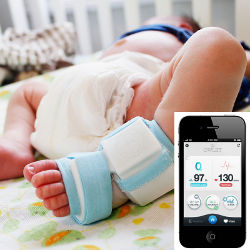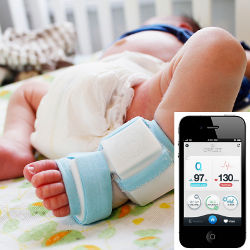
The average person sees his or her physician for about an hour each year. At our annual checkups, doctors and nurses check our blood pressure, heart rate, and other vital signs, and from those brief snapshots they attempt to determine our overall health. Until recently, monitoring these metrics outside the office, and over long stretches of time, would have been neither affordable nor efficient. Today, however, the average person carries a versatile medical gadget on them at all times.
“A smartphone has become a medical device of the highest potential,” says Sreeram Ramakrishnan, manager of Insights-driven Wellness Services with IBM’s Health Informatics group. “The type of sensors that have already evolved are clearly establishing that there’s no technological limit. You could capture almost anything you want.”
Smartphones can measure your heart rate, count your steps, and tell you how well you sleep at night. It is not just our phones; there has been a boom in health-centric devices offering a broad range of medically relevant statistics.
The BAM Labs sensor, packed deep inside a mattress, monitors heart rate, respiration, and overall sleep quality throughout the night. The popular RunKeeper app, which makes use of a smartphone’s GPS to track its users’ running routes and speed, can also talk to cloud-linked scales that measure your weight and body mass index, over-the-counter blood pressure cuffs, and wristbands that keep tabs on your activity during the day, when you are not out racing. All of this data is then pulled together into an easy-to-read graph that offers a more complete picture of your health.
For several years now, experts have been saying this sort of digital technology could revolutionize the health care system, leading to a fundamental shift in the way patients interact with their doctors. Instead of seeing physicians only when something goes wrong, patients using these apps and devices could work together with their providers to lead healthier lives and reduce the frequency of sick visits. “Today we have a sick care system, not a wellness system,” says Stephen Intille, a computer scientist in the Personal Health Informatics group at Northeastern University in Boston, MA. “You’d like to see a world where you have these personal devices keeping you healthy.”
For several years, experts have been saying digital technology could revolutionize the health care system.
The technology could also be a tremendous help to people battling long-term problems, such as hypertension, by allowing them to track their progress over time and potentially address issues before they become too serious. For this more efficient, data-driven health care system to become a reality, though, several significant hurdles need to be overcome.
Moving Beyond the Fitness Crowd
First, many of these health-centric devices are not always accurate. IBM’s Ramakrishnan points out that if you wear a pedometer on each leg, their step counts vary significantly at the end of the day. Yet he says it is not the technology alone that prevents these gadgets from having a greater impact on health care. The accuracy and reliability of the devices will improve, but the technology also has to reach beyond the fitness crowd to a broader audience. “These devices have centered onto a self-selected audience of people who are already healthy,” he notes.
At Northeastern University, Intille is working on strategies to engage patients who need the most help, such as those suffering from hypertension, by empowering them to take control of their own health.
The more popular fitness applications often use competition as a motivator, allowing users to compare themselves to others. Yet Intille says this will not work with the average person hoping to lower his or her blood pressure or lose weight. If your phone suddenly prompts you to get up and move because you have been sedentary too long, or even just pings you to take your medicine, you will most likely ignore the advice. “If you design a technology that tells people what to do, that becomes very annoying,” he says. “Spouses can’t get away with that. Why would we think a mobile phone would?”
Instead, Intille and his group are working on a more positive approach. For example, they are developing applications that tap into a phone’s accelerometer to make assumptions about a user’s posture and ambulation—whether the individual is up and moving around—and then compare this information to the individual’s baseline behavior in real time. When the individual goes for a walk at a time they typically are sedentary, the application might offer the person a digital pat on the back in the form of an encouraging message. “We wait until they do something better than average, then give them subtle reinforcement,” he explains.
“Physicians are overloaded already. If you bring in all your data, are they going to be able to understand it? Will they have time to look at it?”
Intille and colleagues at Duke University are currently conducting a randomized trial of a weight-loss app. The results are not yet available, but Intille says this kind of study is one of the other missing pieces when it comes to personal health devices. “Most of what’s out there in the commercial world, it hasn’t been proven that it works,” Intille notes. “If we can provide evidence that some of these things do work, more than just having people buy the stuff, then I think you’ll see rapid adoption.”
Dealing with the Data
At the same time, the prospect of rapid adoption is not exciting to everyone. Steven Steinhubl, director of Digital Medicine at the Scripps Translational Science Institute, says many health care providers express concern at the notion of patients tracking their own vital signs. They worry these devices could have a negative impact on the doctor-patient relationship, and that doctors will end up seeing their patients even less than they do today.
There is also some concern patients will not know what to do with the rush of data they collect, and that all these numbers could boost anxiety rather than health. Doctors could be equally stumped as to how to deal with all that information. “Many of us would like to see a world where you could collect data yourself and then bring it in to your physician,” says Intille. “The challenge is that physicians are overloaded already. If you bring in all your data, are they going to be able to understand it? Will they have time to look at it?”
John Moore, an MIT Media Lab alumnus, recently co-founded Twine Health, a startup focused on forging more productive digital connections between patients and their health care providers. A former physician, Moore envisions patients working with their doctors to establish certain health goals, then using devices and apps to track their progress. In one of his group’s studies, patients initially consulted with a doctor or nurse and set a goal of lowering their blood pressure to a certain level. The providers avoided the paternalistic approach common to the traditional doctor-patient relationship, in which the physician simply told the patient what to do. Instead, they mutually agreed on how to use a combination of exercise, diet, and medicine to lower their blood pressure.
Moore believes the shift in approach was just as important. The patients were encouraged to make health decisions on their own.
After that initial meeting, the patients interacted with a tablet application that displayed their daily schedules and informed them when certain actions were due to be completed. They would indicate when they took the prescribed pills, and they regularly used a smart blood pressure cuff that relayed their vital signs to the tablet and to the physician’s office. As with Intille’s work, there was no pestering, but patients could converse with a nurse through the tablet and receive encouragement for sticking to the regimen.
The results, Moore says, were outstanding. “One hundred percent of the patients reached their blood pressure goal,” he says. “We achieved dramatically better results at substantially lower costs.”
The savings were attributed in part to the tablet app, which allowed the patients to connect with their providers without having to schedule an office visit. Yet, Moore believes the shift in approach was just as important. The patients were encouraged to make health decisions on their own. “People really responded to that,” Moore says. “When we interviewed them at the end, they said no one had ever asked them to be in charge.”
A Concerted Effort
Regardless of whether or not the larger population chooses to be more proactive in the next few years, the boom in connected medical devices does not look to be slowing down. Rumored smartwatches from HTC and other companies, possibly even Apple, would open the doors for even more health-related data. Since it would regularly be in contact with our skin, a watch could potentially gather more accurate data on stress levels and offer continuous heart rate monitoring.
Joe Bondi, chief technical officer at RunKeeper, is excited about the possibility of more accurate, continuous heart rate monitors, since existing technology does not work as well for users on the run. A monitor built into ear buds, for example, might be able to deliver better results. “There’s a lot you can do in terms of coaching if you know someone’s heart rate,” he says.
Despite the pace of technological development, experts caution all these devices and digital platforms will not force major change quickly. “I do believe that this is the future of healthcare, but you can’t just throw the technology out there and hope it will cure everything,” says Steinhubl.
“It’s going to take a really concerted effort of payers and providers and industry support to say we’re going to totally reengineer health care and take advantage of this technology.”
Further Reading
Eric Topol
The Creative Destruction of Medicine. Basic Books, 2012.
Boulous, M., Wheeler, S., Tavares, C., Jones, R.
How Smartphones are Changing the Face of Mobile and Participatory Healthcare. Biomedical Engineering Online, 10:24, 2011.
Dunton, G.F., Dzubur, E., Kawabata, K., Yanez, B., Bo, B., and Intille, S.
Development of a Smartphone Application to Measure Physical Activity Using Sensor-Assisted Self-Report. Frontiers in Public Health, 2013.
Moore, J., Marshall, M.A., Judge, D., et. al.
Technology-Supported Apprenticeship in the Management of Hypertension: A Randomized Controlled Trial. JCOM, March 2014.
“The Wireless Future of Medicine” A video overview of the promise of connected medical devices: http://www.ted.com/talks/eric_topol_the_wireless_future_of_medicine






Join the Discussion (0)
Become a Member or Sign In to Post a Comment